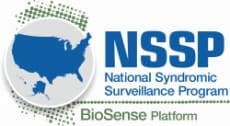CDC Heat & Health Tracker Uses NSSP Data
Extreme heat events threaten public health. CDC’s Heat & Health Tracker, launched June 2021, is an intuitive, easy-to-use dashboard that provides information to inform public health messaging and help people make decisions about personal protective behaviors during extreme heat events.
The tracker includes syndromic data drawn from the National Syndromic Surveillance Program (NSSP). These data display the rate of emergency department (ED) visits associated with heat-related illness, or HRI, per 100,000 ED visits by region (as defined by the U.S. Department of Health and Human Services) for the selected day or week. Contributed by state and local health departments, these data are near real-time and actionable. Communities can use local heat and health information to better prepare for and respond to extreme heat events.
Although some populations are more vulnerable than others, anyone can be at risk to the health effects of heat. Hot weather is associated with an increase in heat-related illnesses, including cardiovascular and respiratory complications, renal failure, electrolyte imbalance, kidney stones, negative impacts on fetal health, and preterm birth.1
Shown below is heat-related illness across the United States. You can check out how the tracker works here and explore how extreme heat affects your county, populations at risk, and response resources.

NSSP is a collaboration among CDC, federal partners, local and state health departments, and academic and private sector partners who have formed a community of practice. They collect, analyze, and share electronic patient encounter data received from emergency departments, urgent and ambulatory care centers, inpatient healthcare settings, and laboratories. To learn more, see the NSSP Fact Sheet.
1CDC Heat & Health Tracker [Internet]. Atlanta (GA): CDC Tracking Network. 2021 [cited 2021 July 14]. Available from: Heat & Health Tracker (cdc.gov)
